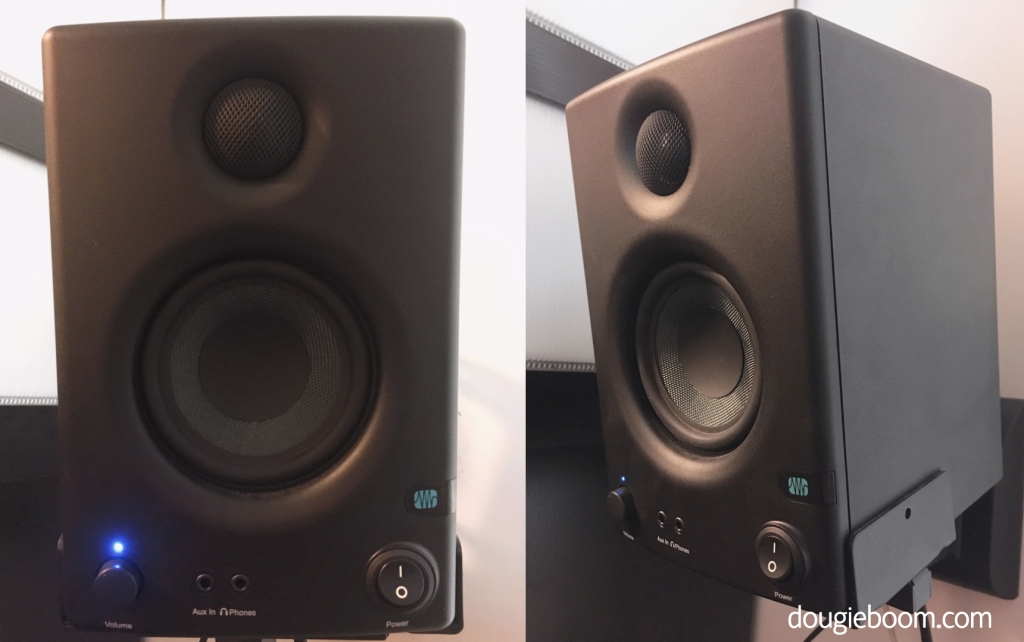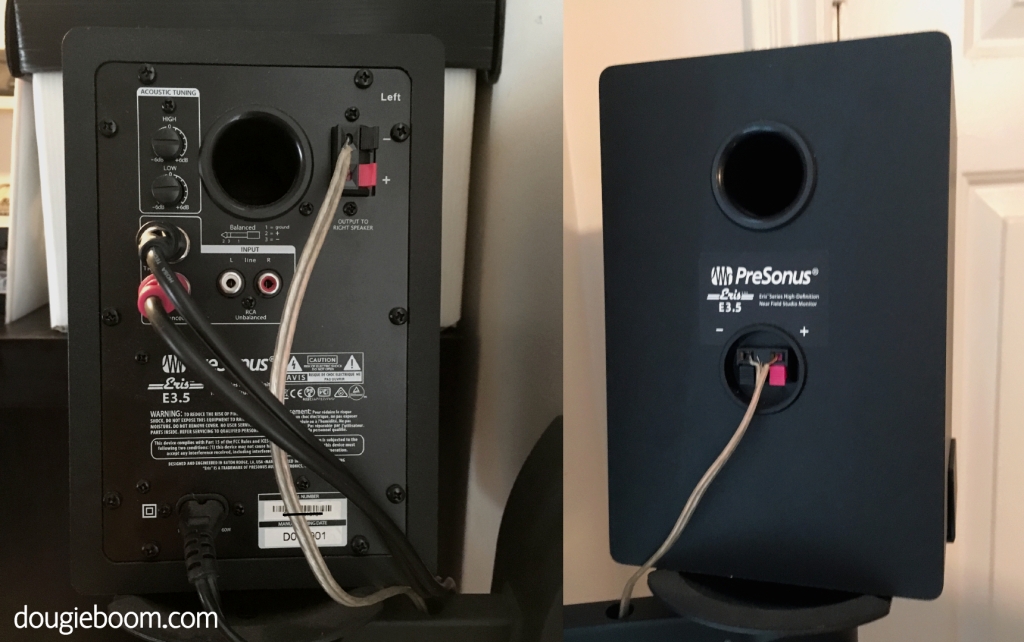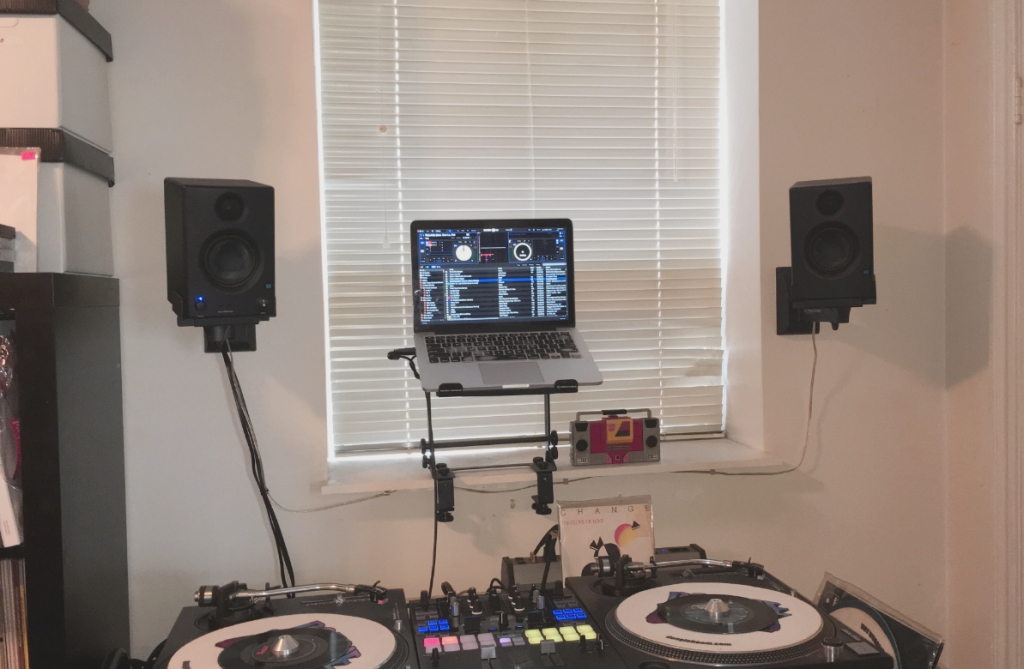
Last year I was looking for a speaker monitor solution for my home DJ booth set up. I wanted a pair of small lightweight speaker monitors that offered relative good clarity for a small price. My intention was to hang the speakers over my DJ booth which sits close to a wall. So, I didn’t want huge speakers that jutted out too far (as to be too close to my ears), nor did I want the speakers to obstruct my DJ space. Furthermore, I didn’t want the speakers to be too heavy, as it would be harder to mount and didn’t want big heavy speakers precariously hanging over my gear. (I know, try mounting them properly). I do have a pair of QSC CP8 but even these for their small size seemed like overkill for this purpose, if I am just DJing in my small studio/dj room. Also, I didn’t want to have to dismantle the CP8 speakers every time I needed them for a gig. I was looking for in situ speakers that would be ready anytime I wanted to DJ or listen to records.
More DJ Tech reviews:
REVIEW: QSC CP8 SPEAKER – A DJ’S LIL BEST BUD?
TRACK FREEZE PROBLEM WITH ROLAND DJ-505 & REVIEW
For years, I would practice DJing or listening to records in my headphones almost exclusively. I still do often but you are really limiting your experience by not listening to music or DJing on speakers. There is something magical and sound altering that happens once music is played through the air. So, it is really important to experience both for perspective. Also, I realized that once I wanted to start making DJ mixes on vinyl again (without computers or screens), you need speakers to do “old school” cueing: previewing the next track in your headphones before you drop it into the main mix. This makes only using headphones problematic. So, that is when I decided I needed speakers to make analog DJ mixes.
Listen to Dougie Boom’s All-Vinyl Mixes!
Alternatively, for speakers I looked at the Pioneer DJ DM-40BT DJ Studio Monitors (only RCA inputs), the Mackie CR Series CR3-3-Inch (wow, that’s some green colour) and the KRK Rokit 4 (that’s a lot of bass). However, after much consideration I went with the PreSonus Eris E3.5 Professional Multimedia Reference Monitors. Now, after a year of use I can say that I am happy with the purchase. The Eris E3.5 sound great! Good clarity and flexibility. I was worried that these speakers would not be much better than your conventional computer speakers. However, I was wrong and they have exceeded my expectations.
PreSonus Eris E3.5 Features

First off, these are not a bass heavy type of speaker. For that I would consider the KRK Rokits with its front ports are known to be a bassier speaker. If you are mostly listening to bass heavy music then you may prefer those instead. For me I was looking for something more neutral sounding. I own Yamaha Monitors for my studio and they are extremely flat but clear in their response (what you hear is what you get). That is not to say that the bass on these Eris do not meet my expectations. A smoother more subtle bass is delivered by the E3.5’s 3″ woven composite woofers. A 1″ silk dome tweeter offers clear highs that aren’t too harsh. The speakers are plenty loud at 25 watt/side power amplifier. Its more than enough volume, considering my use and its proximity. The E3.5’s are active (powered) so they don’t require an external mixer or a power amp.
The speakers have a low profile with a width of 5.6″ (141 mm), a depth of 6.4″ (162 mm) and a height 8.3″ (210 mm). The speaker cabinets themselves (I thought were plastic) are actually medium-density fiberboard with vinyl-laminate, so some of the sound is preserved.

On the back it includes a stereo RCA input (unbalanced) but the real kicker is the inclusion of 1/4″ balanced inputs! A little bit unusual for a speaker of its size, most would use 1/8″ or RCA, but the choice to include them is so appreciated. I would say 60-70% of the DJ mixers or controllers out there have a 1/4″ outputs (for the booth outputs or otherwise), so hooking a DJ mixer with a stereo 1/4″ cable sounds great and is seamless. It includes two EQ controls on the back for highs and lows (-6dbs to + 6dbs). The AC port is a female C7 2-Pin style port, which is easily replaceable and non-proprietary.
On the front, we have the volume and power switch conveniently placed, making it easy to access. Most monitors usually have these controls on the back, but this works especially for our purpose of being wall-mounted. Also on the front there is the inclusion of a 1/8″ headphone jack and aux in jack, which both sound pretty good as well. The ‘on’ light, although not adjustable in brightness, is a soft blue and will not burn holes in your eyes.

Presonus Eris E3.5 Conclusion
The Presonus Eris E3.5 have become more useful to me than expected! I use them now all the time: listening to my DJ blends, previewing finished mixes and songs, preparing for gigs, and listening and grading 45 records. Yes the Eris E3.5 are that discriminating in sound! You will hear vinyl records with pops and all. But most importantly I hear great balanced sound coming from my Pioneer S9’s booth outs. Once you get the eq-ing right (from its controls on the back), taking in consideration the room and how far they are placed from the wall, just as you would normal studio monitors.
I was worried that the speakers would not be able to take the signal from my mixer without overloading or sounding terrible, but I was and still am really happy with them. Some critiques complained that the rear ports allow the bass to be absorbed by nearby walls. However, mounting them away from the wall with speaker mounts, gave them adequate space from the wall and eliminated that problem for me.
For mounting them, I used Primecables Speaker Wall Mounts, which are another bargain and are easy to set up. Plus they are Canadian company. You can tilt them to almost any specification and they hold up to 55 lbs, easy for the Eris’ 3.5 lbs each.
Lastly, it should be noted I would never consider the PreSonus Eris E3.5 as “gig” worthy speakers. These are more so for home/personal use, as inexpensive but great sounding studio monitors. However, they make a great powered speaker solution for your home DJ set up. It should be noted these do not have bluetooth, which keeps these lower in cost. Instead, you get great sounding speaker for your money and, alternatively, you could easily attach a bluetooth receiver instead, and let’s face it, wireless technology will always get better.
PreSonus Eris E3.5 – Pros
- Powered small speaker solution, which will work for most home DJ set ups.
- Excellent sound (no glaring highs and nice smooth bass)
- Great value at $150 CAD price well worth it.
- Proper 1/4″ inputs (which suits most DJ mixer’s booth outputs) but also has 1/8″ and RCA inputs as well.
- Speakers this good could ultimately be used somewhere else if you upgrade (e.g. portable studio monitors).
PreSonus Eris E3.5 – Cons
- The supplied stereo speaker wire to connect between speakers could be longer (depending on your set up). I had to get a longer one.
- EQ controls (pots) on the back feel cheap.
- Not an overtly bass-y pair of speakers, if you are going for a more club-heavy feel. Possible these could be paired with a subwoofer. However, it should be noted there are NO Subwoofer out ports.
